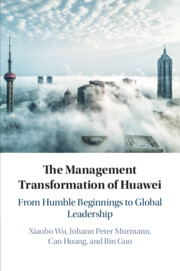Book contents
- The Management Transformation of Huawei
- The Management Transformation of Huawei
- Copyright page
- Contents
- Figures
- Tables
- Contributors
- Preface
- 1 The Management Transformation of Huawei
- 2 The Executive Management Team and Organizational Change
- 3 Transforming Product Development at Huawei
- 4 Huawei’s Transformation of Supply Chain Management
- 5 Financial Management Transformation in Huawei
- 6 The Transformation of Huawei’s HR System
- 7 Huawei’s Internationalization Journey
- 8 Huawei’s R&D Management Transformation
- 9 Huawei’s Intellectual Property Management Transformation
- 10 The Management Transformation of Huawei
- Book part
- Index
- References
10 - The Management Transformation of Huawei
Concluding Thoughts from a Comparative Perspective
Published online by Cambridge University Press: 21 March 2020
- The Management Transformation of Huawei
- The Management Transformation of Huawei
- Copyright page
- Contents
- Figures
- Tables
- Contributors
- Preface
- 1 The Management Transformation of Huawei
- 2 The Executive Management Team and Organizational Change
- 3 Transforming Product Development at Huawei
- 4 Huawei’s Transformation of Supply Chain Management
- 5 Financial Management Transformation in Huawei
- 6 The Transformation of Huawei’s HR System
- 7 Huawei’s Internationalization Journey
- 8 Huawei’s R&D Management Transformation
- 9 Huawei’s Intellectual Property Management Transformation
- 10 The Management Transformation of Huawei
- Book part
- Index
- References
Summary
This chapter offers concluding thoughts on the entire Huawei study – the totality chapters and commentaries. It offers comparative perspective by placing the firm in the larger context of corporations in China and to some extent in other countries. The comparison with many other firms throughout the entire book reveals that Huawei is among a select number of firms that are able grow at very high rates by continuously transforming themselves. Consistently investing at least 10 percent of sales starting on R&D at least since 1998 was an important ingredient of this growth. But the importation of western best practice routines and the steering of this process by the Huawei founder and the top management team underlie this ability to grow. Huawei stands out among many Chinese companies that internationalize by relying solely on organic growth rather than on growth through acquisitions. Huawei is also different from state-owned companies (SOEs) that dominate a number of sectors in the Chinese economy in that Huawei motivated a large fraction of employees by giving them shares in a profit-sharing plan so that hard working employees could make a substantial amount of money. Building all chapters, we provide advance management theory by articulating in detail the meta-routines that underpin Huawei’s dynamic capabilities. Finally, we discuss the challenges to future growth of the firm, including geopolitical cross-currents the firm currently finds itself in.
Keywords
- Type
- Chapter
- Information
- The Management Transformation of HuaweiFrom Humble Beginnings to Global Leadership, pp. 381 - 410Publisher: Cambridge University PressPrint publication year: 2020
References
- 2
- Cited by



